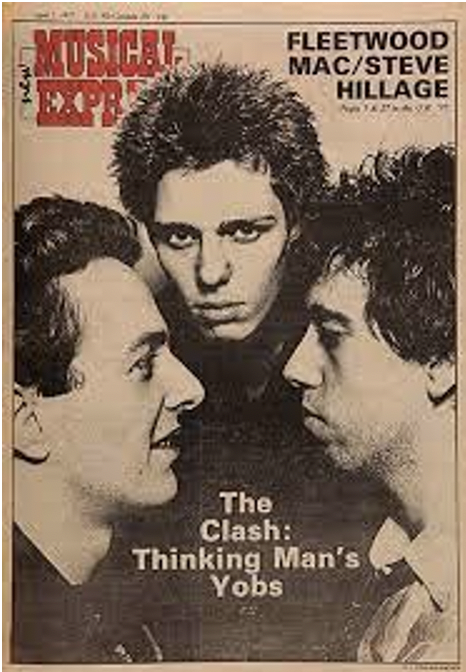Throughout my unheralded scribing life, I have tried to write cogently about rock and roll. I don’t know if I’ve ever done a decent job, some might say so now and again, but there is always the sound of one hand clapping. I was weaned on the good critics, Lester Bangs, Dave Marsh, Nelson George, Julie Burchill, Nick Kent, Mick Farren, and above all Charles Shaar Murray (CSM). CSM wrote for the weekly New Musical Express (NME) out of London in the 70s and 80s, and he was my favorite. He taught me how to put the words down about the shit that mattered. He did it much better than I ever could.
Yesterday, I visited my friend Bill C in the hospital. Bill is suffering from the cancer and getting the treatment. He’s a big musico, both as a listener and as a creator and bandleader. I brought him an old book from my library called Shots From the Hip by CSM to cheer him up. It’s a series of CSM’s album and concert reviews. Bill is up in Columbia Presbyterian Hospital in Washington Heights, far away from our nearby neighborhood homes in Brooklyn. On the long subway trip, I had a chance to re-read some old CSM articles from his chronicle. This is about a few of them.
It feels odd to write about somebody who writes about somebody else who writes songs and makes music. It might be a cheap number. I think not. Hell, I’m going to give it try.
On the #2 train, I am reading a CSM review about a Bruce Springsteen and the E Street Band concert in Houston, Texas, 1975. He begins by telling us that in his opinion none of the albums matter, that the live shows explain it all. He is sitting drinking a lousy milkshake and steak sandwich in a diner, an hour after the gig. Houston is an impossible place (or was as far as my memory goes). It barely has sidewalks and virtually no public transport, especially late at night. But Houston aside, CSM has just seen the Springsteen show. He lets on to us, “This cat is good!”
And then he explains why. For him, it’s a combination of punk and black soul rhythm and blues. Most people would not regard Bruce Springsteen as a punker. But CSM does. It’s raw music. The edge is aided by the saxophone honking of Clarence Clemons. It blares a different kind of roughness. And Springsteen seems to have a handle on R&B, not as a thief but as a respectful scholar. CSM also explains away the Dylan comparisons that Time Magazine was harping on about then. Springsteen might want to pour out his lyrical soul on vinyl, but on stage it is the pure show. And it is mesmerizing. It all made sense to me when I read his review. What pathfinders did in 1975 had a bit more oomph. They were woke in a different kind of way. I’ve seen performances from that particular period on dvd. CSM was right. Think about it.
So I was sold on that one. It wasn’t just that the music was enticing, it was that the description of the allure was magnetic. Man I thought to myself, I want to capture a reading audience like that. And write for a weekly music rag to boot.
Around about Times Square, I paged to CSM’s coverage of an Ian Dury & the Blockheads concert, London 1979. CSM says that Dury is your all-cockney everyman. He writes that the artist is happy and comfortable in that world. And now that the anthems like “Sweet Gene Vincent,” “Wake up and Make Love to Me,” and “Plaistow Patricia” are acceptable and are demanded by the audience, the magic that they deservedly acquired a few years earlier has softened. That’s difficult for me to believe, since they are tremendous songs. But CSM is a hard man. However, he relents when “Dance of the Screamers” is performed. That’s a mother of a tune and he has to admit it.
I saw Ian Dury twice in London 1978 at the Hammersmith Odeon. The crowd alone was spectacular. Minnie Pearls (old dears dressed in all white with phony pearl jewelry), Pigeon Joes (with homing birds on their shoulders) and sideshow street artists like jugglers and card trick conmen poured in. Dury, himself a polio victim with a club foot, limped on stage with a boxer’s gown draped over his shoulders. In golden letters on the back, it read “Champ.” These were magnificent exhibitions. And CSM finally fessed up to that in his article. Sometimes art intersects with entertainment, even rock and roll. I knew that and I was happy to read that CSM got that too, even if it took him up to 72nd Street to get there.
As I swapped over to the local at 96th Street, I turned to the Elvis Presley obituary. CSM’s take was that whenever the system creates an idol, he or she is usually doomed to failure. So the drop-dead handsome boy who could sing like an angel becomes an obese coke-head who dies of a heart attack on the toilet seat. He deals with fame here, and the notion that it does not have a whole lot to offer. CSM posits that when success is reduced to being able to buy more stuff than any one person might ever possibly need, the whole exercise becomes meaningless. It’s hard to disagree here. He recognizes what Elvis brought to the table. He also realizes that the table was eventually set for a glutton.
In the hospital room, Bill looks good despite what he has been through, which is brutal. We chat and occasionally he naps. I hope he gets a chance to page through the CSM opus. If I could tell those stories as well as CSM, Bill might not have drifted off.

